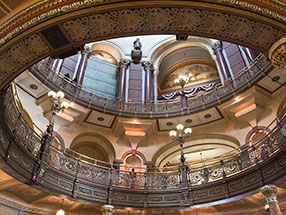A monumental late-April news event in Europe that has received limited attention in the United States could find its way into debate on a legislative proposal to end Illinois’ 40-plus-year ban on building large nuclear power plants.
Here’s how CNBC described what happened on April 28:
“A catastrophic power outage affecting much of Spain, Portugal and the south of France has thrust the role of renewables and energy security into the spotlight. … The outage, which lasted for several hours, plunged much of the region into darkness, stranded thousands of train passengers and left millions without phone or internet coverage or access to cash from ATMs.”
Spanish authorities immediately announced an investigation to determine the “root cause of the incident.”
But energy-policy skeptics immediately focused on the heavy reliance Spain and Portugal place on wind and solar power as a possible cause.
That prompted U.S. Energy Secretary Chris Wright to comment that “when you hitch your wagon to the weather, it’s just a risky endeavor.”
Here’s something else to consider.
News reports indicate that The Power Bureau consulting firm predicts that Illinois’ demand for energy will outstrip its supply by 2030. That includes natural demand increases in energy plus new ones coming from energy required for data centers and artificial intelligence.
Maybe wind and solar issues are unrelated to Europe’s energy-grid woes. Maybe the consultants are wrong about Illinois supply and demand increases. Maybe it doesn’t matter because Illinois can meet its energy needs through other sources.
Then again, maybe it’s a problem the state’s elected officials can’t ignore.
That’s one reason why there’s pending legislation in Springfield to lift the ban on large nuclear reactors in the hope that energy concerns will choose Illinois to build.
The General Assembly is scheduled to end its current session May 31, and that doesn’t leave a lot of time for passage. History, however, has shown that legislation can move at warp speed when powerbrokers like Gov. J.B. Pritzker and Democratic legislative leaders want it to do so.
There is precedent for moving on the nuclear-power issue.
Last year, the legislature passed and Pritzker signed a law that provided a partial repeal by permitting the construction of small modular reactors.
These are described by the International Atomic Energy Agency as “advanced nuclear reactors that have a power capacity of up to 300 (megawatts) per unit, which is about one-third of the generating capacity of traditional nuclear power reactors.” They can provide power to about 300,000 homes.
Before he signed the legislation, however, Pritzker insisted the Legislature continue the ban on large nuclear reactors. The governor recently has hinted he’s amenable to changes, but declined to be more specific.
The official hostility to nuclear power is somewhat ironic because Illinois currently hosts 11 nuclear reactors at six plants, including one in Clinton. Nuclear power supplies the energy needs of Chicago.
Time, of course, is an issue in much more than the legislative process.
A large nuclear power plant can take more than a decade to build. At the same time, there has been no groundbreaking response to the statutory change allowing construction of the smaller reactors.
That leaves open the following question: If Illinois allows it, will they build?
Legislative proponents take heart in the bipartisan support the proposal has attracted. They’ve even expressed optimism that a change is coming.
Its current status — the proposal is stuck in a legislative logjam — indicates otherwise.


